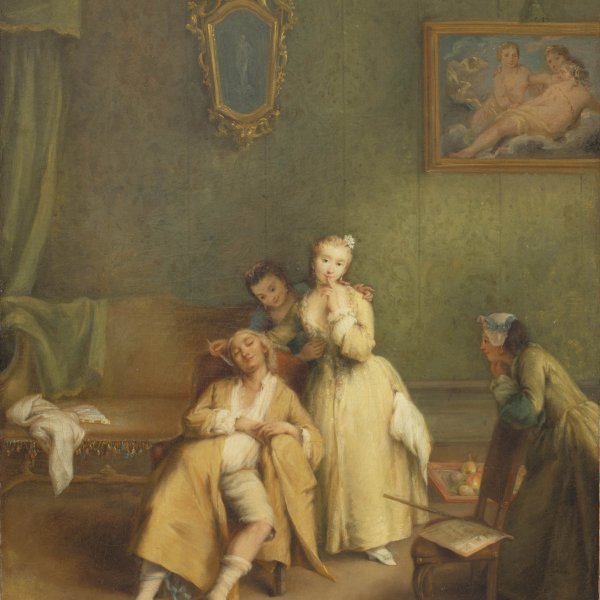Pietro Longhi
Venice, 1702-1785
Son of Alessandro Falca, a painter and goldsmith active in Venice, Pietro Longhi was the quintessential artist of the Venetian bourgeois classes during the 18th century. It is not known why or at what date he changed his surname to Longhi, nor is there any surviving documentation on the artist prior to 1732 when he married in Venice. According to his son, the painter Alessandro Longhi, Pietro trained for some years in the studio of Antonio Balestra, a follower of Carlo Maratta. It has also been suggested that he may have studied with Giuseppe Maria Crespi.
Nothing is known of the artist’s activities between 1734 and 1737 but it was during this period that he abandoned historical compositions in favour of small genre scenes. In 1737 Longhi is registered for the first time in the fraglia or painters’ guild of Venice. The chronology of his output is difficult to establish as his works are not dated but it is known that his early genre scenes depicted everyday episodes such as La Polenta (Ca’Rezzonico, Venice), and scenes of dances and taverns such as The Drunkard (private collection, Biella) and The happy Couple (Ca’Rezzonico).
In 1741 Longhi painted The Concert (Gallerie dell’Accademia, Venice), a small-format work with a pale, harmonious colour range, set in the interior of a Venetian palace. For the remainder of his career Longhi repeated scenes of this type, which brought him fame and renown and his works adorned the palaces of the leading Venetian families.
Nothing is known of the artist’s activities between 1734 and 1737 but it was during this period that he abandoned historical compositions in favour of small genre scenes. In 1737 Longhi is registered for the first time in the fraglia or painters’ guild of Venice. The chronology of his output is difficult to establish as his works are not dated but it is known that his early genre scenes depicted everyday episodes such as La Polenta (Ca’Rezzonico, Venice), and scenes of dances and taverns such as The Drunkard (private collection, Biella) and The happy Couple (Ca’Rezzonico).
In 1741 Longhi painted The Concert (Gallerie dell’Accademia, Venice), a small-format work with a pale, harmonious colour range, set in the interior of a Venetian palace. For the remainder of his career Longhi repeated scenes of this type, which brought him fame and renown and his works adorned the palaces of the leading Venetian families.





